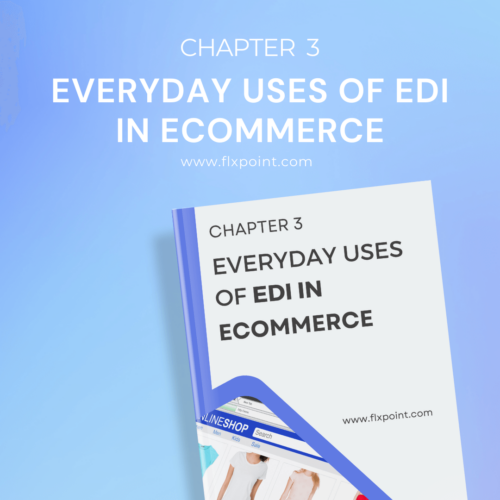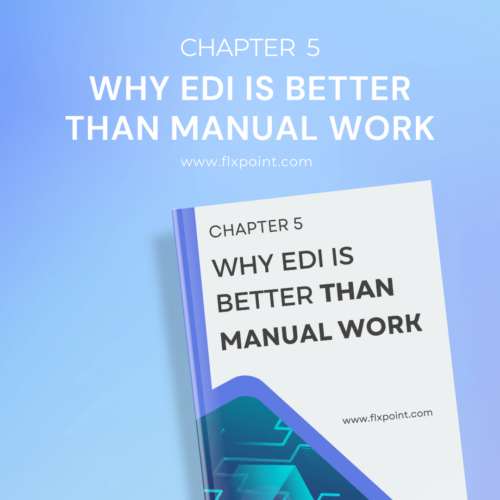Chapter 7 The Future of EDI in Ecommerce
Look ahead at EDI's role in ecommerce. This chapter discusses trends, innovations, and how EDI will continue to shape the industry's future.

Chapter 7: The Future of EDI in Ecommerce
EDI began as a way to automate the exchange of documents like purchase orders and invoices between businesses. Initially, it relied on dedicated networks and complex software. With the advent of the internet, EDI has become more accessible and integrated with ecommerce platforms. In today’s fast-paced digital world, efficiency and accuracy are paramount. EDI streamlines order processing, reduces manual errors, and accelerates transactions. It enables real-time data exchange, improving inventory management and supply chain visibility. Ecommerce is constantly evolving. To remain relevant, EDI must adapt to emerging technologies like cloud computing, artificial intelligence, and blockchain. Integration with ecommerce platforms, APIs, and mobile devices is crucial. Furthermore, EDI must address the growing demand for data security and compliance with evolving regulations.
Cloud-Based EDI – A Game Changer
What is Cloud-Based EDI?
Cloud-based EDI is a modern approach to electronic data interchange that operates through internet-hosted platforms rather than on-premise systems. Unlike traditional EDI, which requires dedicated infrastructure and software, cloud-based EDI uses a centralized, online environment to process and share data. This makes it easier for businesses of all sizes to implement EDI without significant upfront costs.
Explanation of Cloud-based EDI and its Benefits Over Traditional EDI.
- Hosted in the Cloud – Cloud-based EDI systems operate online, eliminating the need for on-premise hardware.
- Accessible Anywhere – Users can access data and processes from any device with an internet connection.
- Real-Time Updates – Data synchronization ensures faster communication between trading partners.
- Lower Maintenance Costs – Service providers handle updates and maintenance, reducing internal IT burdens.
- Scalable Solutions – Cloud-based EDI grows with your business, adapting to increasing transaction volumes.
How Cloud Systems Reduce Costs and Increase Accessibility.
With cloud EDI, companies save on installation, IT staffing, and operational costs. Providers manage the infrastructure, ensuring security, updates, and scalability. Accessibility improves since businesses can easily integrate cloud EDI with ecommerce platforms, enabling real-time data exchange. This flexibility ensures that companies remain agile, even as their supply chains grow more complex.
Advantages of Cloud-Based EDI
Cloud-based EDI is transforming the way businesses manage their data exchange processes. It offers significant benefits compared to traditional on-premises EDI systems, making it an attractive solution for modern ecommerce businesses.
- Faster Implementation and Updates – Cloud-based EDI solutions are ready to deploy, eliminating the need for complex installations. Updates and patches are handled automatically, ensuring businesses always operate with the latest features and security enhancements. This reduces downtime and allows for seamless operations.
- Enhanced Scalability for Growing Businesses – As businesses expand, their data exchange needs to grow too. Cloud-based EDI systems scale effortlessly to handle increasing transaction volumes or new trading partners. This flexibility is invaluable for ecommerce businesses looking to adapt to seasonal demands or rapid growth.
- Better Data Security and Compliance – Cloud EDI providers implement advanced security measures, such as encryption and secure servers, to protect sensitive data. These systems are also designed to meet global compliance standards, such as GDPR or HIPAA, giving businesses confidence in their legal and ethical operations.
- Cost-Effectiveness – With cloud-based EDI, businesses avoid the costs associated with hardware, maintenance, and IT staff. The pay-as-you-go model ensures that businesses only pay for what they use, optimizing budgets.
- Increased Accessibility – Accessing EDI data from anywhere is a significant advantage of cloud solutions. Teams can collaborate in real time, improving communication and decision-making.
Why Ecommerce Businesses Prefer Cloud EDI
One of the most significant advantages is the ability to seamlessly integrate with ecommerce platforms. By connecting tools like Shopify, WooCommerce, and others, businesses can streamline their operations and eliminate manual data entry. Real-time data syncing further enhances efficiency, enabling faster order processing and accurate inventory management across the supply chain.
Easy Integration with Ecommerce Platforms.
- Compatible with leading platforms such as Shopify and WooCommerce.
- Reduces setup complexity and shortens implementation time.
- Offers plug-and-play solutions for immediate benefits.
Real-time Data Syncing for Improved Supply Chain Efficiency.
- Synchronizes inventory updates instantly across channels.
- Ensures accurate stock levels to prevent overselling or stockouts.
- Enhances visibility into order status, shipping updates, and tracking.
The Role of Emerging Technologies in EDI
Artificial Intelligence (AI) in EDI
How AI Automates Data Validation and Error Correction
Artificial Intelligence (AI) is transforming EDI by making data validation and error correction faster and more accurate. AI algorithms can automatically scan EDI transactions for inconsistencies, missing fields, or incorrect formats. These systems flag errors in real-time and often correct them without human intervention.
For example, AI can identify mismatched purchase orders and invoices, ensuring smooth transactions between suppliers and buyers. This reduces the time spent manually reviewing data and lowers the chances of costly mistakes, making operations more efficient. By automating these tasks, AI enables businesses to focus on strategic decision-making instead of routine error management.
Enhancing Predictive Analytics for Demand Forecasting
AI-powered predictive analytics revolutionize demand forecasting by using historical data, market trends, and external factors to predict future needs. For ecommerce businesses, this means anticipating stock requirements and avoiding overstock or shortages. AI analyzes large datasets quickly and identifies patterns that humans might miss.
For instance, it can predict seasonal demand spikes for specific products, helping businesses prepare in advance. By integrating AI-driven forecasting with EDI, companies can automate reordering processes and optimize inventory levels. This ensures better customer satisfaction and reduces waste, ultimately driving profitability.
Internet of Things (IoT) and EDI
Emerging technologies like the Internet of Things (IoT) are transforming EDI by making data sharing more dynamic and efficient. IoT devices seamlessly integrate with EDI systems to improve real-time tracking, inventory management, and logistics. These advancements create a more connected supply chain, reduce errors, and enhance overall productivity.
Connecting IoT Devices for Real-time Inventory Updates.
- IoT sensors track inventory levels automatically in warehouses.
- Devices send real-time data to EDI systems, ensuring accurate stock records.
- Prevents overstocking or understocking by triggering automated restocking orders.
- Improves customer satisfaction with precise product availability updates.
Streamlining Supply Chain Logistics with Automated Data Sharing.
- IoT-enabled devices provide live updates on shipment locations and conditions.
- Automates communication between suppliers, distributors, and retailers.
- Reduces delays by flagging potential issues, like transport disruptions.
- Ensures compliance by sharing regulatory data in real time
Blockchain and EDI
Ensuring Secure and Transparent Transactions
- Blockchain creates tamper-proof records, reducing fraud risks.
- Transactions are verified through decentralized systems, ensuring accuracy.
- All parties in the supply chain can view updates, improving transparency.
- Data encryption adds an extra layer of security.
Tracking Products Across the Supply Chain with Immutable Records
Blockchain technology enables end-to-end tracking of products in the supply chain. Each transaction or update is recorded as a block in the chain, creating a permanent and unchangeable ledger. This ensures full traceability from the manufacturer to the customer.
For ecommerce businesses, blockchain with EDI enhances trust by providing accurate, real-time information about product origins, movement, and status. If issues like delays or defects arise, businesses can quickly pinpoint the source. Customers also benefit from greater confidence in product authenticity, improving brand reputation. By integrating blockchain into EDI, businesses can build a more efficient and transparent supply chain that meets modern expectations.
EDI as a Bridge Between Physical and Online Stores
Connecting Omnichannel Retail Strategies
How EDI Helps Manage Inventory Across Physical and Digital Storefronts
- Centralized Data Management – EDI synchronizes inventory across physical and online stores in real time.
- Accurate Stock Levels – Ensures customers see only in-stock items, reducing overselling.
- Streamlined Supply Chain – Automates order fulfillment from the nearest warehouse or store.
- Seamless Restocking – Tracks sales data and triggers automatic replenishment for physical stores.
- Efficient Returns Management – Coordinates return processes across different channels.
Ensuring Seamless Customer Experiences in Hybrid Shopping Models
EDI plays a vital role in offering consistent and reliable service in omnichannel retail. By integrating data across platforms, it enables features like “buy online, pick up in store” (BOPIS). Customers can shop online and collect items at their convenience, knowing the product is reserved for them. EDI ensures accurate order tracking and real-time updates, so customers are informed at every step. EDI supports smooth returns and exchanges, regardless of the purchase channel. This level of efficiency enhances trust and loyalty, making hybrid shopping both convenient and reliable for modern consumers.
Real-Time Data for Brick-and-Mortar Stores
Enabling Just-in-Time Restocking – With real-time data from EDI systems, brick-and-mortar stores can track inventory levels accurately. When stock runs low, automated restocking orders are triggered, ensuring the store doesn’t run out of products. This minimizes overstocking and reduces waste.
Sharing Sales Data Between Locations for Optimized Operations
Sharing sales data across multiple locations allows stores to make informed decisions. For instance, a location running low on popular items can be restocked from a nearby store with surplus stock, improving stock utilization.
- Enables efficient transfer of stock between stores.
- Identifies trends and customer preferences across locations.
- Provides centralized reporting for better decision-making.
Supporting Click-and-Collect Models
Simplifying Order Management for In-store Pickups.
- EDI automates the order transmission from online stores to physical locations, allowing staff to quickly prepare the items for pickup.
- It eliminates manual input, reducing human errors and delays in processing orders.
- With EDI, in-store employees can instantly access order details and prioritize tasks, enhancing operational efficiency.
Ensuring Accuracy in Real-time Stock Levels and Order Updates.
- EDI enables real-time syncing of inventory data across physical and online stores, ensuring that stock levels are always accurate.
- As soon as an order is placed online, EDI updates the inventory to reflect the purchase, avoiding overselling or stockouts.
- The system allows instant updates for customers, notifying them of their order status and when it’s ready for pickup.
Conclusion
EDI will continue to play a vital role in the success of ecommerce. Cloud-based EDI solutions enhance accessibility and scalability. Artificial intelligence can automate processes, improve data analysis, and predict demand. The Internet of Things (IoT) enables real-time visibility and control across the supply chain. Blockchain technology enhances security and transparency in transactions.
EDI is crucial for seamless omnichannel experiences, ensuring consistent order fulfillment across all sales channels. By investing in future-proof EDI systems, businesses can gain a competitive advantage, improve efficiency, reduce costs, and enhance customer satisfaction. Adapting to these advancements is essential for businesses to thrive in the ever-evolving ecommerce landscape.
Guide Chapters
- Chapter 1: What is EDI?
- Chapter 2: How EDI Helps Ecommerce Businesses
- Chapter 3: Everyday Uses of EDI in Ecommerce
- Chapter 4: How to Start Using EDI
- Chapter 5: Why EDI is Better Than Manual Work
- Chapter 6: EDI vs. APIs: What's the Difference?
- Chapter 7: The Future of EDI in Ecommerce
- Chapter 8: Your First Steps with EDI
- Chapter 9: EDI is the Future of Ecommerce
- Chapter 10: Quick Glossary of EDI terms
- Chapter 11: Checklist to Prepare for EDI Setup
All Chapters in This Guide

Start with the essentials. This chapter breaks down what EDI is, how it works, and why it’s a critical tool for modern ecommerce businesses. We simplify the technical jargon so you can clearly understand how EDI automates the exchange of business documents with your suppliers, warehouses, and trading partners.

Explore the powerful benefits EDI brings to your ecommerce operations. From faster communication and fewer errors to cost savings and improved accuracy, this chapter shows how EDI makes your business leaner, smarter, and more competitive.

See how EDI shows up in real day-to-day workflows. This chapter highlights common applications like order placement, shipping confirmations, inventory updates, and invoicing—so you can understand the practical ways EDI supports smooth operations.

Ready to get started? This chapter walks you through the process of adopting EDI, including evaluating your current tech stack, selecting the right partners, and integrating EDI into your existing systems. No technical background required—we make it approachable.

If you're still relying on spreadsheets, emails, or manual uploads to exchange data, this chapter is a game-changer. Learn how EDI eliminates human error, speeds up workflows, and allows your business to scale without adding more headcount.

Wondering when to use EDI or APIs? We break down the differences between these two powerful tools, when each makes the most sense, and how they can work together in a well-rounded ecommerce tech stack.

EDI is evolving rapidly. In this chapter, we explore upcoming innovations—like machine learning, tighter integrations with fulfillment partners, and greater automation. Discover how to stay ahead of the curve and be ready for what’s next.

It’s time to take action. This chapter provides a hands-on guide to assessing your business readiness, aligning with trading partners, and identifying the tools you need to implement EDI smoothly and successfully.

This isn’t just a short-term solution—it’s a long-term strategy. Learn why businesses adopting EDI today are better positioned to grow, adapt to change, and lead in a digitally connected ecommerce world.

EDI doesn’t have to be intimidating. We’ve created a glossary of key terms and acronyms to make the language of EDI more accessible, so you can communicate confidently with partners and providers.

Make sure you’re truly ready. This checklist walks through everything you’ll need to set up EDI the right way—from choosing the right platform to aligning your workflows and evaluating technical requirements. Consider this your pre-launch playbook.
Kenneth Cole's Smart Savings With Shopify EDI Connections
"They had never used Flxpoint before. But working with [the Flxpoint] team, they learned it and we're about to onboard our newest footwear partner, and you know that's big business for us.”
Mitul PatelKenneth Cole


How Flxpoint Helped Rifle Supply Automate & Grow
“I went line by line… whatever the inventory number was and cost value was, I calculated it and was blown away by how much that was worth— $300 million worth of product that I added to our web store.”
Chris MekdaraRifle Supply


The Ecommerce Automation Behind Screen Skinz
"Automation is the key to maximizing your volume. [Flxpoint] comes right into our flow — everything's automated. We want it to be quick and efficient. So that's what we love about Flxpoint."
Shaun Brown & Clay CanningScreenSkinz


How Inhaven Transformed Vendor Management with Flxpoint
"We ended up switching to Flxpoint, and it has been a much smoother process. Where it took us six months to get onboarded with the other company, we were up and running in a week or two with Flxpoint."
Ashley ChingInhaven


How Black Patch Performance Scaled Smarter with Flxpoint
"The only way to actually scale was to go through Flxpoint… You can’t even come close to hiring someone to do what Flxpoint does for the price."
Jonathan WilliamsBlack Patch Performance


